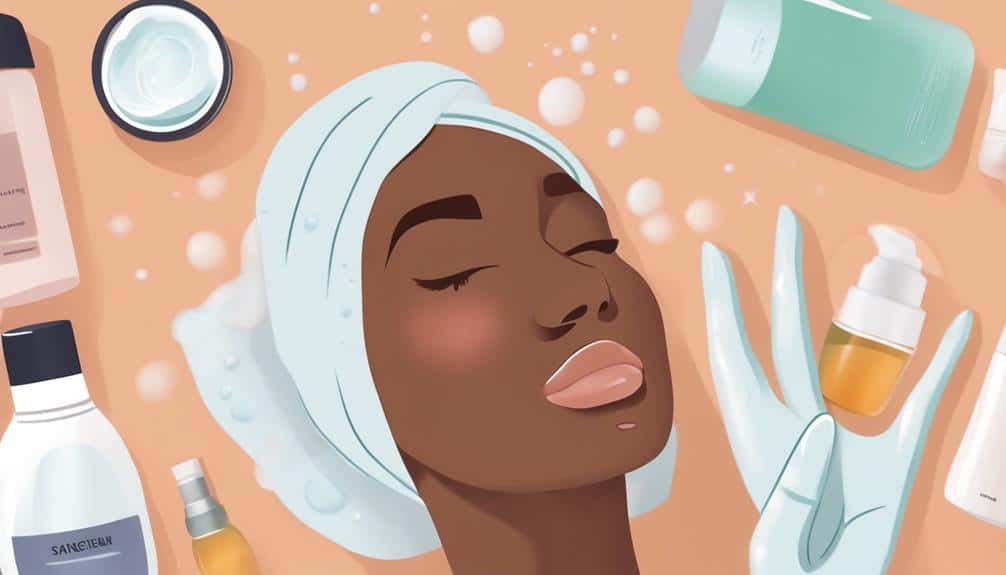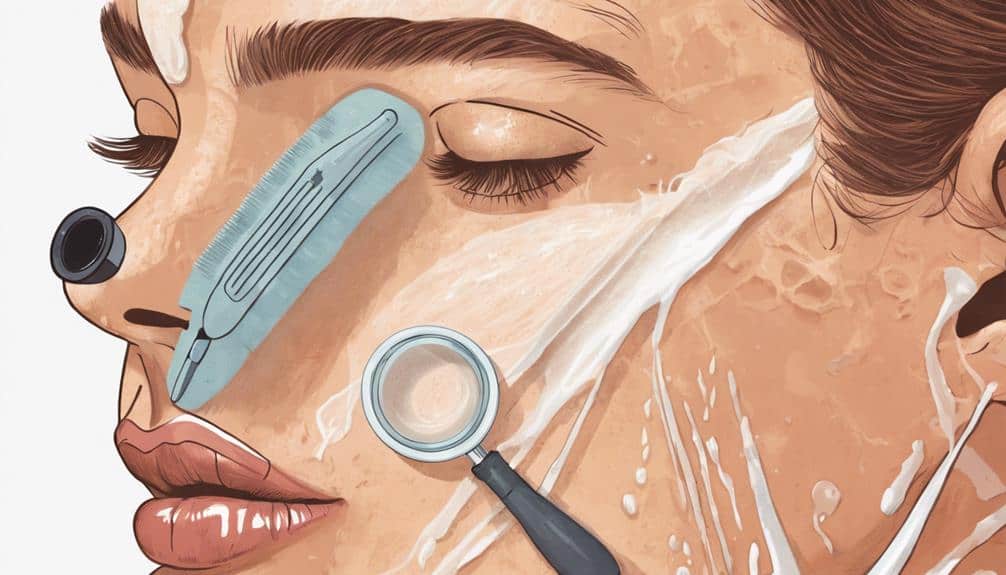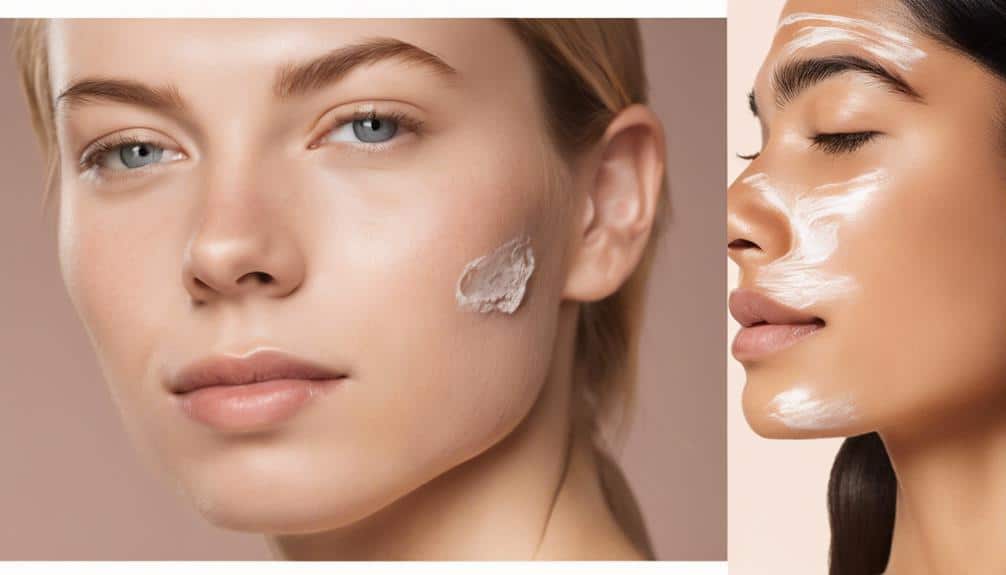After shaving, you should wait at least 24 hours before waxing to allow your skin to recover from micro-cuts and sensitivity, ensuring a more comfortable and effective hair removal experience. This waiting period helps your skin heal and become more receptive to waxing. You'll want to make sure your hair is at least 1/4 inch long for proper wax grip. Now that you know the wait time, it's time to prepare your skin for a successful waxing experience – and there's more to learn about getting ready for a smooth, hair-free finish.
Key Takeaways
• Allow your skin 24 hours to recover from shaving before waxing to minimize sensitivity and ensure a comfortable experience.
• Shaving causes micro-cuts in the skin, leading to increased sensitivity, making it essential to wait before waxing.
• Waiting 24 hours enables the skin to heal and become more receptive to waxing, ensuring a more effective hair removal process.
• Ensure hair is at least 1/4 inch long for optimal waxing results and to allow the wax to grip the hair properly.
• Waxing too soon after shaving can lead to increased sensitivity, discomfort, and potential skin irritation.
Understanding the Waiting Period
After shaving, allow your skin a minimum of 24 hours to recover before waxing to minimize sensitivity and guarantee a more comfortable experience.
This waiting period is essential, as it allows your skin to recover from the shaving process, reducing the risk of irritation and discomfort during waxing.
You see, when you shave, you're causing micro-cuts in your skin, which can lead to increased sensitivity. By waiting, you give your skin time to heal, making it more receptive to the waxing process.
This wait time also allows your hair to grow out slightly, which is vital for effective waxing. Remember, your hair should be at least 1/4 inch long for the wax to grip properly.
Preparing Your Skin for Waxing

To guarantee a successful waxing experience, prepare your skin by taking a few simple steps that will make the process more comfortable, effective, and long-lasting.
Allow the hair to grow long enough, at least 1/4 inch, to make sure of effective removal and help prevent ingrown hairs.
Exfoliate your skin before waxing to remove dead skin cells and prepare the hair follicles for extraction. This will also help reduce skin irritation and make the process less painful.
Moisturize your skin to reduce discomfort during and after the waxing process.
Avoid sun exposure before waxing to prevent skin sensitivity and potential irritation.
Finally, shower before waxing to open up the pores and make hair removal easier and less painful.
By following these steps, you'll be well-prepared for a successful waxing experience.
Proper after-care is also essential to maintain the results and prevent any adverse reactions. By taking these precautions, you'll be on your way to smooth, healthy-looking skin that will last.
Choosing the Right Wax Method

When selecting the right wax method after shaving, you'll need to take into account the type of wax, temperature control, and preparation of the area to be waxed.
You'll have to choose between wax strips and hard wax, each with its own benefits and drawbacks.
Wax Strips Vs. Hard Wax
You're likely familiar with the two most popular waxing methods: wax strips and hard wax, each with its own strengths and ideal uses. When deciding between the two, consider the area you're waxing and your personal preferences.
Wax strips are ideal for larger areas like legs and arms, as they allow for quick and efficient hair removal. On the other hand, hard wax is better suited for sensitive areas like the bikini line, as it adheres to the hair more than the skin, reducing skin irritation.
If you have coarse hair, hot waxing may be the way to go, especially for areas like the underarms. However, if you have sensitive skin, you may want to opt for sugaring, a natural paste that's gentle on the skin.
Ultimately, consider your pain tolerance and skin sensitivity when choosing the right waxing method for your needs. By selecting the right wax type, you can minimize discomfort and achieve a smooth, hair-free result.
Wax Temperature Control
Your waxing experience hinges on mastering wax temperature control, an essential factor in choosing the right method for effective hair removal.
Different waxing methods, such as strip waxing, hard waxing, sugaring, and hot waxing, offer varying temperature requirements. Understanding these temperature requirements is vital for a successful waxing session.
Here are some key temperature control considerations:
- Hard wax is ideal for sensitive areas, as it's applied at a lower temperature and removed without strips.
- Hot waxing, effective for coarse hair, is heated to a higher temperature to provide better grip and removal.
- Proper temperature control ensures safe and efficient hair removal during waxing sessions.
Waxing Area Preparation
To achieve ideal waxing results, consider the unique characteristics of your skin and the area being waxed when selecting a wax method from the various options available, including strip waxing, hard waxing, sugaring, and hot waxing. The right method will depend on your pain tolerance, skin sensitivity, and the area being waxed.
| Wax Method | Suitable For | Benefits |
|---|---|---|
| Strip Waxing | Larger areas (legs, arms) | Quick, efficient, and cost-effective |
| Hard Waxing | Sensitive areas (bikini, underarms) | Gentle on skin, removes coarse hair |
| Sugaring | All skin types | Natural, gentle, and exfoliating |
| Hot Waxing | Coarse hair removal | Effective for thick, stubborn hair |
Before waxing, properly prepare your skin by gently exfoliating, avoiding lotions or oils, and ensuring the hair is the recommended length for effective removal. This preparation will help minimize discomfort and achieve optimal results. Remember, shaving and waxing have different requirements, so be sure to adjust your preparation accordingly. By choosing the right wax method and preparing your skin, you'll be on your way to achieving smooth, hair-free skin.
Post-Waxing Skin Care Tips

When it comes to post-waxing skin care, you'll want to soften the skin and exfoliate gently afterwards to maintain smooth, healthy-looking skin. By doing so, you'll reduce the risk of ingrown hairs and prevent skin irritation.
Soften the Skin
After waxing, apply a soothing gel or lotion with aloe vera to calm and hydrate the skin, reducing redness and inflammation. This helps to soften the skin, making it more comfortable and reducing the risk of irritation. You'll be amazed at how this simple step can make a big difference in your post-waxing experience.
Here are some additional tips to help you soften the skin and prevent common issues:
- Hydrate the skin: Keep the waxed area moisturized to help it heal faster and reduce dryness.
- Prevent infections: Keep the waxed area clean and dry to prevent infections or irritations.
- Gentle exfoliation: Gently exfoliate the skin to prevent ingrown hairs and maintain smoothness.
Exfoliate Gently Afterwards
You'll want to gently exfoliate your skin post-waxing to prevent ingrown hairs and maintain smooth skin texture. This essential step in your post-waxing skin care routine helps remove dead skin cells, allowing new hair to grow back easily after waxing.
Be cautious not to over-exfoliate, as harsh methods can irritate the skin or cause redness. Instead, opt for a gentle scrub or brush to keep your skin healthy and free from ingrown hairs. Regular exfoliation can also reduce the likelihood of bumps and irritation after waxing.
By incorporating gentle exfoliation into your routine, you'll enjoy smoother, healthier-looking skin that's less prone to ingrown hairs. Remember, gentle is key – avoid using harsh products or rough scrubs that can strip your skin of its natural oils.
With regular, gentle exfoliation, you'll be on your way to maintaining smooth, radiant skin that looks and feels amazing.
Common Mistakes to Avoid

To guarantee a successful waxing experience after shaving, it's crucial to avoid common pitfalls that can lead to subpar results, skin irritation, and even long-term damage. By taking the time to understand what can go wrong, you'll be better equipped to achieve the smooth, radiant skin you desire.
Here are three common mistakes to avoid:
- Not waiting long enough after shaving: Waxing too soon can cause ingrown hairs, irritation, and even infection. Wait at least 24 hours to allow your skin to recover.
- Not letting your hair grow long enough: If your hair is too short, the wax won't be able to grip it properly, leading to uneven results. Let your hair grow to at least 1/4 inch for optimal waxing.
- Not maintaining healthy skin habits: Failing to exfoliate regularly, hydrate, and avoid harsh chemicals can cause skin irritation and ingrown hairs. Take care of your skin, and it will thank you with a smooth, radiant glow.
Waxing After Shaving Benefits

In addition, waxing after shaving offers you a more efficient hair removal solution, allowing you to enjoy smooth skin for a longer period. This is especially beneficial for those who undergo Brazilian wax treatments, which require more frequent maintenance.
With waxing, you can eliminate the need for daily shaving for up to four weeks, saving you time and effort. Additionally, waxing exfoliates and removes hair from the root, resulting in a smoother skin surface. As you continue with regular waxing sessions, you'll notice finer hair regrowth, making the hair less noticeable.
This is particularly important for individuals with sensitive skin, as waxing can minimize discomfort and reduce the occurrence of ingrown hairs. By choosing waxing after shaving, you can achieve longer-lasting results and enjoy a more convenient hair removal experience.
What to Expect During Waxing
During a waxing session, anticipate your skin to undergo a brief period of mild discomfort as the wax strips remove hair from the root, particularly if you've shaved recently. This sensitivity is normal and usually subsides within a few hours. To minimize discomfort, consider using a numbing cream or taking an over-the-counter pain reliever before your appointment.
Here are some key things to keep in mind during the waxing process:
- Redness or irritation: This is a common reaction, especially after shaving. It should fade within a few hours.
- Increased sensitivity: Your skin may be more sensitive after waxing, especially if you've shaved recently. Avoid direct sunlight, tight clothing, and harsh products for a few days.
- Getting waxed regularly: Regular waxing can lead to thinner, softer regrowth and reduced sensitivity over time.
Remember to follow proper skin preparation and after-care instructions to ensure a smooth, effective waxing experience. By understanding what to expect, you can better prepare yourself for a successful waxing session.
Frequently Asked Questions
How Soon Can I Wax After Shaving?
You're wondering how soon you can wax after shaving? Typically, it's best to wait at least 24 hours to allow your skin to recover from shaving. This delay helps reduce discomfort and guarantees a more effective waxing experience.
In the meantime, focus on exfoliating and moisturizing to prep your skin. By waiting, you'll get better results and minimize potential issues like ingrown hairs.
How Long to Wait Before Waxing Again?
When considering how long to wait before waxing again, you'll want to allow your skin sufficient time to recover.
As a general rule, wait at least 3-4 weeks after your previous waxing session before waxing again. This allows your skin to rejuvenate and regenerate, ensuring a smoother, more effective waxing experience.
What Happens if You Don't Wait 24 Hours After Waxing?
You're playing with fire if you don't wait 24 hours after shaving before waxing. Ignoring this essential window can lead to a world of discomfort, as your sensitive skin becomes a breeding ground for irritation, inflammation, and uneven hair removal.
You'll be more prone to ingrown hairs, and the waxing process will be a painful, ineffective struggle. Don't risk it – give your skin the time it needs to recover, and you'll reap the rewards of a smoother, more comfortable waxing experience.
How Many Waxes Before Hair Stops Growing?
You're wondering how many waxes it takes for hair to stop growing.
The truth is, hair growth isn't completely eliminated, but regular waxing can lead to significant reduction. After 3-4 sessions, your hair growth rate slows, and regrowth becomes finer and softer.
With consistent waxing, you'll notice a significant decrease in hair growth, making maintenance sessions less frequent. However, individual factors like hair texture and growth rate influence the number of sessions needed to achieve this.



